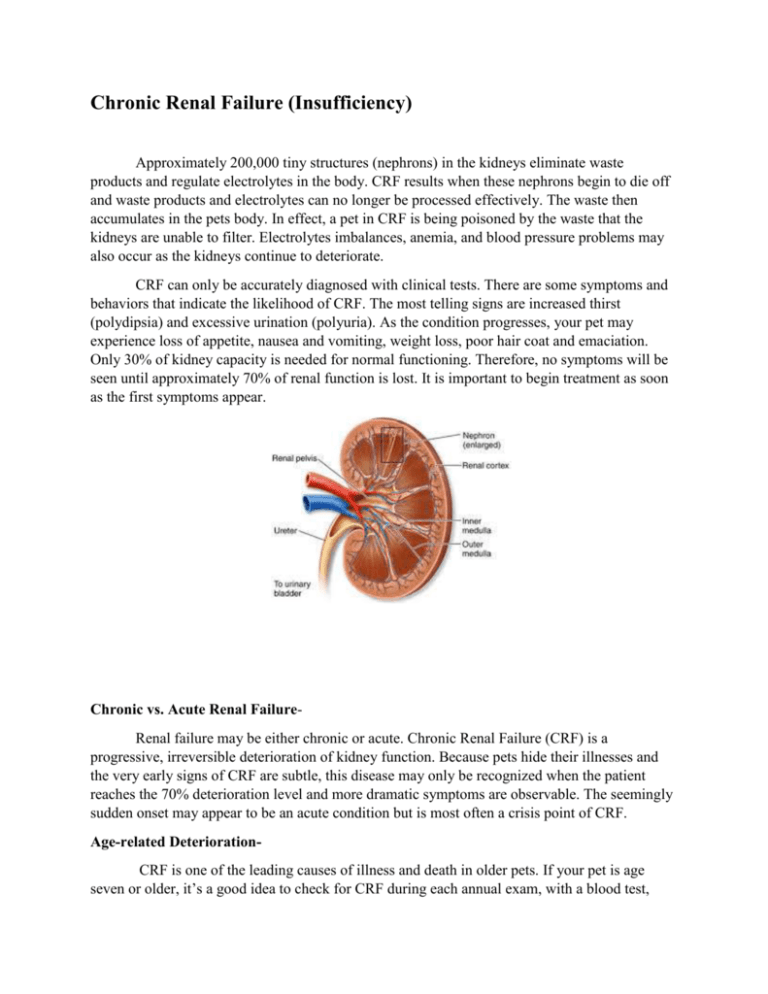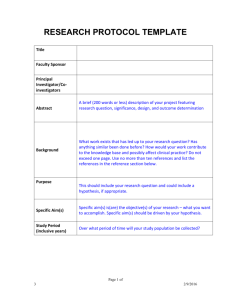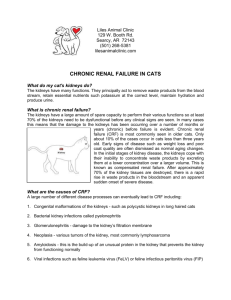Chronic Renal Failure
advertisement

Chronic Renal Failure (Insufficiency) Approximately 200,000 tiny structures (nephrons) in the kidneys eliminate waste products and regulate electrolytes in the body. CRF results when these nephrons begin to die off and waste products and electrolytes can no longer be processed effectively. The waste then accumulates in the pets body. In effect, a pet in CRF is being poisoned by the waste that the kidneys are unable to filter. Electrolytes imbalances, anemia, and blood pressure problems may also occur as the kidneys continue to deteriorate. CRF can only be accurately diagnosed with clinical tests. There are some symptoms and behaviors that indicate the likelihood of CRF. The most telling signs are increased thirst (polydipsia) and excessive urination (polyuria). As the condition progresses, your pet may experience loss of appetite, nausea and vomiting, weight loss, poor hair coat and emaciation. Only 30% of kidney capacity is needed for normal functioning. Therefore, no symptoms will be seen until approximately 70% of renal function is lost. It is important to begin treatment as soon as the first symptoms appear. Chronic vs. Acute Renal FailureRenal failure may be either chronic or acute. Chronic Renal Failure (CRF) is a progressive, irreversible deterioration of kidney function. Because pets hide their illnesses and the very early signs of CRF are subtle, this disease may only be recognized when the patient reaches the 70% deterioration level and more dramatic symptoms are observable. The seemingly sudden onset may appear to be an acute condition but is most often a crisis point of CRF. Age-related DeteriorationCRF is one of the leading causes of illness and death in older pets. If your pet is age seven or older, it’s a good idea to check for CRF during each annual exam, with a blood test, urinalysis and blood pressure measurement. With early detection, proper diet, and hydration, pets may remain happy and active for quite some time before the inevitable decline. What Causes CRF? - CRF may have one or more causes. The common contributing factors are age, genetics, environment, and disease. TreatmentThere is no cure for CRF but the condition may be managed for a time. The cornerstone of CRF management is to control the amount of waste products that are sent through the kidneys. Since the remaining nephrons are limited in their ability to process waste, the idea is to reduce the amount of waste to a level that the nephrons can accommodate. This is done through a combination of diet, medication, and hydration therapy (diuresis). There are three safe, effective tools to manage CRF that we use at Animal Haven Veterinary Center: Azodyl: Beneficial bacteria provide natural “dialysis”. Azodyl is a patented formulation of naturally-occurring, beneficial bacteria that decreases the level of toxins in the blood and helps to prevent further kidney damage by decreasing the workload on taxed kidneys. Epakitin: Decreases phosphorous absorption to help increase life expectancy. It is possible to slow down the progression of CRF by removing excess phosphorous in your pets system. Epakitin contains chitosan which binds to phosphorous in the intestines, decreasing its absorption and reducing the potential for further kidney damage. Renal K+: Supplemental source of potassium for pets with low serum potassium. Pets with insufficient kidney function often lose large amounts of potassium in the urine. Potassium is necessary for heart and muscle function. The symptoms of low levels include lethargy and muscle weakness or pain, especially of the neck. Renal K+ is an easy to administer, highly palatable source of potassium for pets with CRF exhibiting signs of decreased serum potassium. There is also a prescription food called K/D. K/D is recommended for kidney disease, heart disease, oxalate urolithiasis, ammonium urate urolithiasis. K/D is clinically proven to extend life in cats with kidney failure, reduce levels of protein to minimize kidney workload, reduce phosphorus to slow the progression of kidney disease. PrognosisCRF is a terminal disease. The only questions are how long and how well the patient will live until the end. With proper treatment, the pet may have from months to years of relatively high-quality life. As the pets caregiver(s), it is up to you to determine when the quality of life has decreased to a point at which prolonging life no longer has value. As CRF progresses and toxin levels rise, pets become more uncomfortable with an overall sensation of feeling unwell. Human patients with a similar condition don’t report “pain” but describe their condition as feeling poorly. Dehydration, in particular, can make the patient very uncomfortable. Aggressively treating CRF, especially with subcutaneous fluid therapy, should not be thought of as “prolonging the agony” as there is no significant pain associated with kidney failure until the end-stage. Even then, unless the patient convulses, the chief symptoms will be malaise, weakness, nausea and discomfort.






